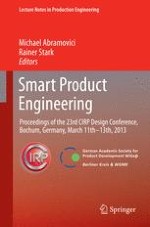The collection of papers in this book comprises the proceedings of the 23rd CIRP Design Conference held between March 11th and March 13th 2013 at the Ruhr-Universität Bochum in Germany. The event was organized in cooperation with the German Academic Society for Product Development – WiGeP. The focus of the conference was on »Smart Product Engineering«, covering two major aspects of modern product creation: the development of intelligent (“smart”) products as well as the new (“smart”) approach of engineering, explicitly taking into account consistent systems integration.
Throughout the 97 papers contained in these proceedings, a range of topics are covered, amongst them the different facets and aspects of what makes a product or an engineering solution “smart”. In addition, the conference papers investigate new ways of engineering for production planning and collaboration towards Smart Product Engineering. The publications provide a solid insight into the pressing issues of modern digital product creation facing increasing challenges in a rapidly changing industrial environment. They also give implicit advice how a “smart” product or engineering solution (processes, methods and tools) needs to be designed and implemented in order to become successful.
